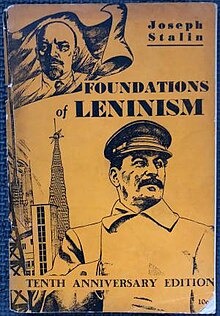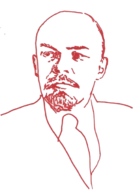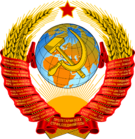Marxism–Leninism
| Union of Soviet Socialist Republics (USSR) |
|---|
| History |
| History of the USSR, Russian Revolution of 1917 (February Revolution, October Revolution), Collapse of the USSR |
| Politics |
| Communist Party of the Soviet Union, Bolshevism, (before 1950s) Marxism–Leninism, Revisionism (after 1956) |
| Economy |
| Economics of the Soviet Union, Five-Year Plans |
| Soviet Republics (from 1956 until dissolution) |
| Armenian SSR, Azerbaijan SSR, Byelorussian SSR, Estonian SSR, Georgian SSR, Kazakh SSR, Kirghiz SSR, Latvian SSR, Lithuanian SSR, Moldavian SSR, Russian SFSR, Tajik SSR, Turkmen SSR, Ukrainian SSR, Uzbek SSR |
Marxism–Leninism is a communist tendency developed by Joseph Stalin as a continuation of Leninist theory. Its creation came about during a period when competing factions within the Soviet leadership attempted to establish their legitimacy as Lenin's political successors following his death. Soviet leaders such as Leon Trotsky, Grigory Zinoviev, and Joseph Stalin wrote works developing the concept of a specifically Leninist ideology. Stalin coined the term to describe an ideology which considers Lenin's political thought to be a necessary development of Marxism, and made the term popular through his 1938 work The History of the Communist Party of the Soviet Union (Bolsheviks).
It was the official ideology of the Soviet Union and other socialist states. After the success of the Russian revolution in 1917 and the establishment of the Soviet Union in 1922, many communist parties around the world began to adopt Marxism–Leninism as their political line, and Marxism–Leninism was the main theoretical framework which guided multiple proletarian revolutions across the globe during the 20th century. Marxism–Leninism continues to be followed by a large portion of the international workers' movement, and is upheld by many communist parties to this day.
Background
Marxism–Leninism was founded on the ideological and political concepts established by Vladimir Lenin following the split with the Mensheviks and opportunists of the Second International up to the Russian revolution of 1917 and formation of the Soviet Union under the Bolsheviks in 1922. After the death of Lenin, leadership of the revolution was entrusted to Joseph Stalin, against the wishes of Trotsky, Zinoviev and others in the Soviet Union. The oppositionists in the Soviet Union would continue to resist the government headed by Stalin until the late 1930s.[1]
The construction of socialism in the USSR helped solidify many theories in the corpus of Marxist–Leninist theory, including socialism in one country and the intensification of class struggle under socialism.
Ideology

Democratic centralism
A Marxist–Leninist party is organized according to democratic centralism. This means that first the party democratically decides something, and then all members are required to follow that decision and not work against it. If members still disagree with the decision, they are expected to request to discuss the issue again, not to form a faction or another party.
Vanguard party
Intensification of class struggle under socialism
Socialist commodity production
Marxist–Leninist theory holds that the nature of commodity production is not strictly or ultimately a capitalist one, and that commodity production may still exist in the lower stage of socialism. In Economic Problems in the USSR, Stalin stated that commodity production still existed in the Soviet Union but was distinct from commodity production under capitalism insofar as the other fundamental features of capitalist relations which would influence it were abolished, and commodity production itself long predated the capitalist mode of production.[2]
Analysis of imperialism
Stalin maintained that Marxism–Leninism was the next stage in the development of Marxism, expanding theory for the era of imperialism and proletarian revolution.[3]
Anti-revisionism
The national question (national liberation and the right of nations to self-determination)
Socialism in one country
Socialism in one country was codified by the Soviet government under Joseph Stalin, basing themselves heavily on the writings of Lenin. This theory holds the socialism is able to be built in a single country or limited expanse of countries even if they are underdeveloped economically. After constructing socialism, the revolutionary country would be able to contend with the imperialist and capitalist states and assist revolutionary movements abroad.[4]
This theory was in direct conflict with the views held by the Trotskyists and other early Soviet factions, who believed that socialism would only be able to develop and resist imperialism by rapidly expanding into other, particularly Western imperialist, countries.[4]
Political economy, crises and revolution
The lower and higher phases of communism
Other forms
Mao Zedong Thought
Marxism–Leninism–Stalinism
Marxism–Leninism–Stalinism is often called "Hoxhaism", but this label is incorrect. Hoxhaists are Leninist–Stalinists.[5][better source needed][disputed ]
Ho Chi Minh Thought
Criticism
Marxist critics argue that Marxism–Leninism works from the assumption that the Soviet Union was a socialist society and use this as reference point to navigate both political theory and practice. The consequence of this being that Marxism–Leninism is reconciled with bourgeois concepts such as the nation-state and nationalism. The most common criticism of Marxism–Leninism from Trotskyists is that rather than seeking to spread the socialist revolution throughout the world through direct revolutionary action, hence pursuing "Proletarian Internationalism," Stalin instead only assisted existing socialist revolutions, believing that the Soviet Union was the only country in the world capable of achieving socialism due to the success of its own revolution, and actually enacted a foreign policy of "peaceful coexistence" with the Western capitalist powers. [citation needed] Stalin named this theory "socialism in one country".
Trotsky
Bordiga
Paul Mattick
References
- ↑ Joseph Stalin (1939). History of the Communist Party of the Soviet Union (Bolsheviks) at Marxists Internet Archive
- ↑ Joseph Stalin (1951). Economic Problems of the USSR — Commodity Production under Socialism at Marxists Internet Archive
- ↑ Joseph Stalin (1924). Foundations of Leninism – Introduction
"Leninism is Marxism of the era of imperialism and the proletarian revolution. To be more exact, Leninism is the theory and tactics of the proletarian revolution in general, the theory and tactics of the dictatorship of the proletariat in particular. Marx and Engels pursued their activities in the pre-revolutionary period (we have the proletarian revolution in mind), when developed imperialism did not yet exist, in the period of the proletarians’ preparation for revolution, in the period when the proletarian revolution was not yet an immediate practical inevitability. But Lenin, the disciple of Marx and Engels, pursued his activities in the period of developed imperialism, in the period of the unfolding proletarian revolution, when the proletarian revolution had already triumphed in one country, had smashed bourgeois democracy and had ushered in the era of proletarian democracy, the era of the Soviets."
"That is why Leninism is the further development of Marxism." - ↑ 4.0 4.1 "Socialism in One Country: What it really means" (25 May 2017) ML-Theory
- ↑ "Revolutionary Spirit: The Marxist-Leninist Guide to Leftist Factions". Revolutionary Spirit. 2010-02-27. Retrieved 2023-01-08.
Sources
http://en.internationalism.org/ir/96/leninists
https://isreview.org/issue/93/zinovievism-and-degeneration-world-communism
https://archive.org/details/25ZinovievLeninizm
https://www.marxists.org/history/etol/newspape/ni/vol10/no03/trotsky.htm
https://libcom.org/library/revolutionary-alternative-left-wing-politics
The History of the Communist Party of the Soviet Union (Bolsheviks) (1938)


